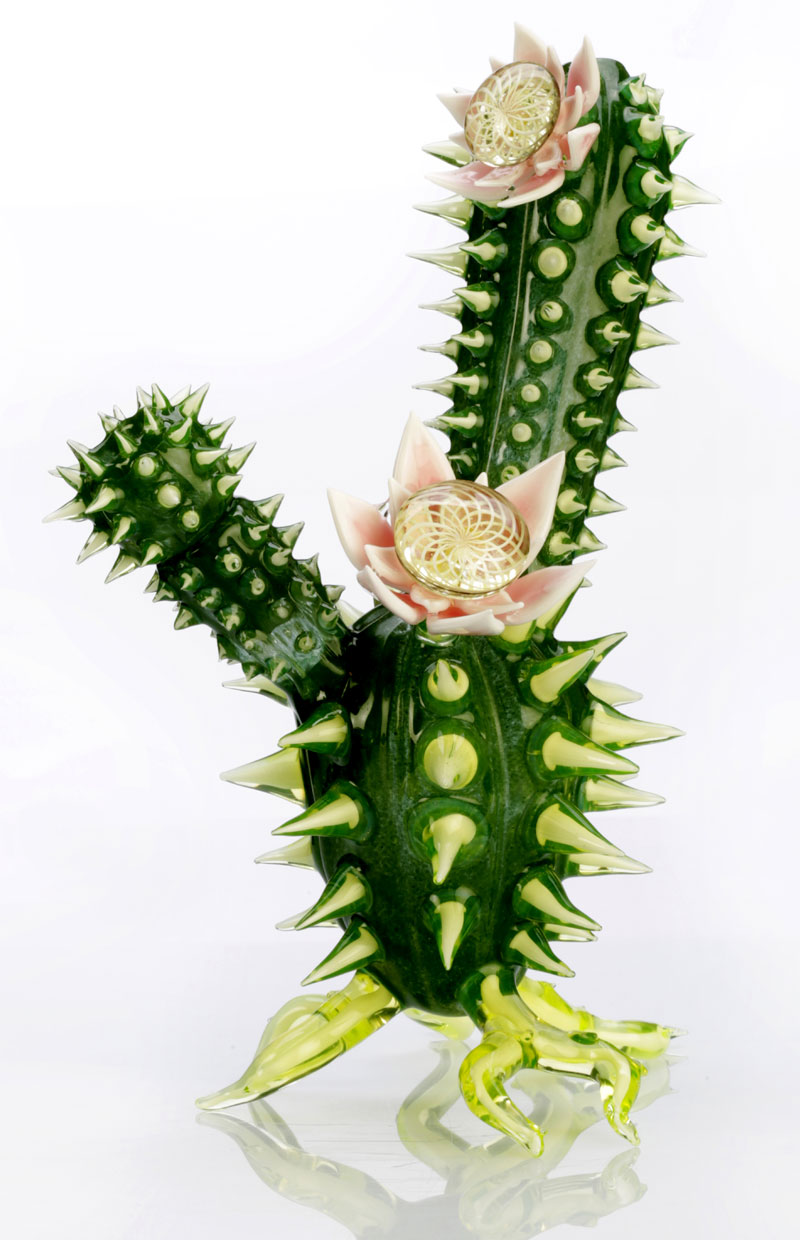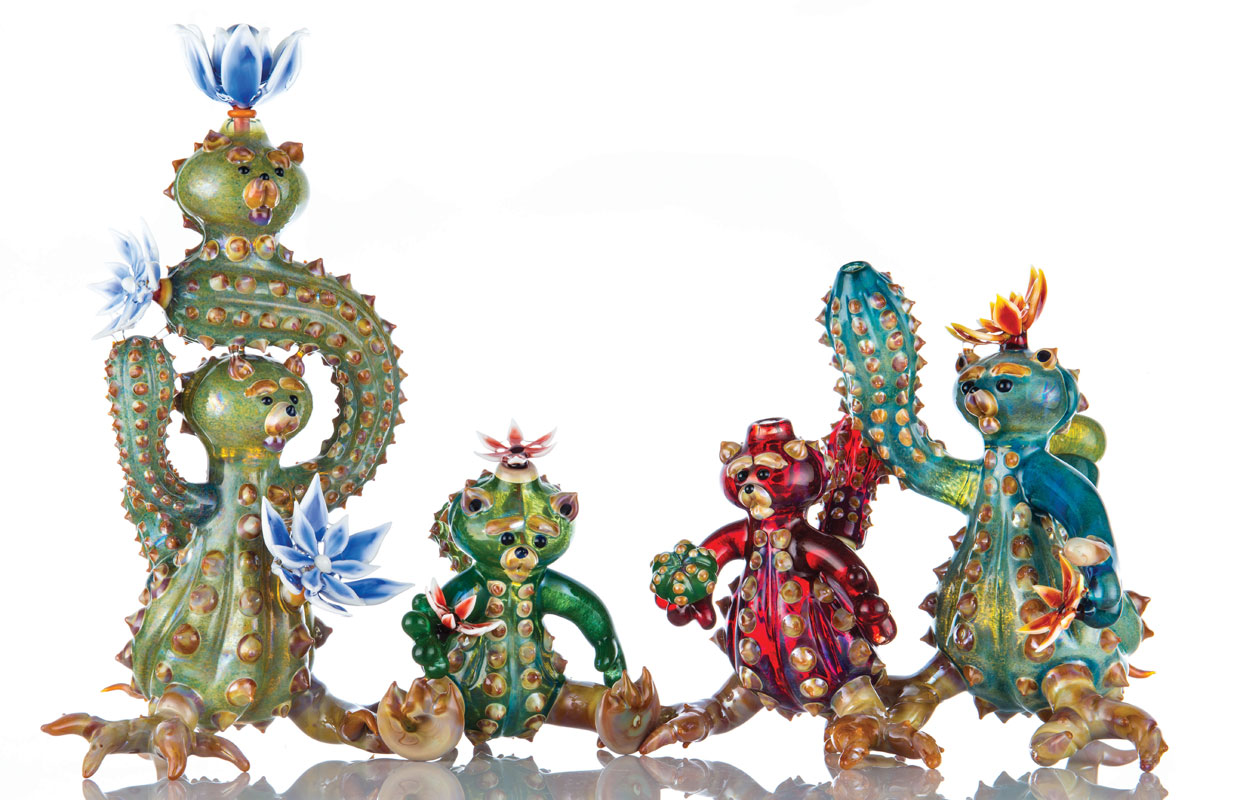Glass Art Profile: Unparalleled Glass, The Sharpest Glass in the West
Chaiah Sullivan of Unparalleled Glass found an artistic home in a prickly sculptural subject: functional borosilicate cacti.
Gaining skills from many of greats in the glass blowing community, Chaiah Sullivan of Unparalleled Glass’ cactus creations look so real you’re almost tempted not to use this functional art in order to avoid the prick of their spines. The hyper-realistic pointy pieces are each meticulously handcrafted from Sullivan’s home studio in the small town of Paonia, Colorado and have become his signature style.
“[The cactus art is] definitely something I do that I feel is very unique and not really something on somebody else’s style that I’ve learned,” Sullivan says. “Everything else I do I really enjoy, but I always feel like it has a little derivative from somebody else whereas the cactus is kind of my own creation.”
Some of the pieces, particularly the large collaborative works, are priced at more than $1,000 and contain several ornate details including special percolation systems and glow-in-the-dark functionality. Sullivan first found the torch in 2005, but became serious about his craft in 2010 when he attended Penland School of Crafts located in the Blue Ridge Mountains of North Carolina. Here, Sullivan got the opportunity to take a class from Janis Miltenberger, a Washington-based artist who works with borosilicate glass to create large-scale narrative sculpture. Like Sullivan, much of Miltenberger’s glass art pulls from botanical elements found in nature such as leaves and flowers.
“Janis Miltenberger was my first-ever class and she is just a great artist,” Sullivan says.
Later Sullivan took a series of collaborative classes at Glasscraft in Golden, Colorado where he had the chance to learn from artists such as Salt and Robert Mickelsen. He came upon the cactus after a friend mistakenly referred to another plant pipe he had created as a cactus and he decided to give making a realistic cactus pipe a try.
“I was really surprised with how realistic it looked and I just had to run with it,” he says. “It’s all, I wouldn’t say sculpting, because I feel like that implies shaping the surface whereas the inside of the glass stays the same, but what I’m actually doing is shaping the glass so the inside and the outside are the same contour of the cactus so it’s kind of like hollow sculpting.”

PHOTO Wind Home
In order to create the pieces Sullivan must use a graphite rod to press in indents while at the same time accentuating the cactus’ ridges. Creating the spines is a highly meticulous process that requires Sullivan to glob on five to 20 dollops of colored rod that are then melted before more can be applied.
“Then I pluck each one, I heat it up with a rod and pluck it out,” he says. “I try to get the fine line between being actually pointy where it will actually stab you, I try not to get to that, but get as close to that as I can so it doesn’t look like they’re rounded edges or anything.”

PHOTO Alex Reyna
While he can complete a cactus sherlock pipe in about two hours, small beakers take four hours and larger pieces, which often involve additional ornamental elements such as a root structure, take quite a bit longer. This summer, Sullivan spent a lot of time participating in Marcel Braun’s Project 33, a collaborative glass community project based in Eugene, Oregon. While at Project 33 he got the chance to work alongside Braun, someone he had previously collaborated with. In their current cactus collaborations you can see Braun’s reticello – a fish net, crisscross design taken from an old Italian technique inverted from soft glass furnace work to borosilicate glassware. And as meticulous as Sullivan’s own work is, he also admires that skill in others.
“It’s a very involved process to make this reticello that has a bubble trapped in every single little diamond that the grid makes,” he says of Braun’s artistry.
And all the little details, such as the spikes on Sullivan’s cactus, can sometimes also improve a piece’s functionality.
“It can, if you really squeeze it, it can make indents in your fingers, but if you’re just holding it gently it’s totally fine,” he says of the glass spines. “In fact it makes it harder to drop because its full of spikes that are there to grip on to and not slip out of your hand.”
Originally published in the print edition of Cannabis Now. LEARN MORE
TELL US, would you buy cactus inspired glass?






















